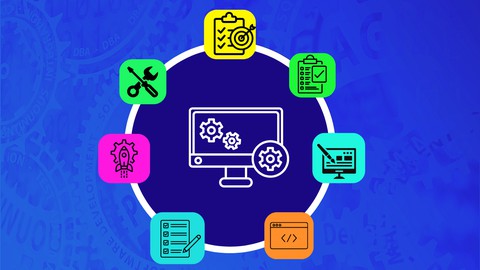Complete SDLC: Software Development Life Cycle SDLC (2023)


Price: 19.99$
This is the first-ever comprehensive SDLC course that covers almost everything that anyone aspiring to learn and progress in the Software field can take up and become as proficient as someone with nearly 10+ years of experience. This course is the gist of my entire decades of experience crafted in 14+ hours of content. Whatever I learned during my career concerning the SDLC Software development Life cycle I have included in this course. No boasting at all, Look at the course curriculum you will get the idea. In these 14 + Hours we are going to learn all the below concepts from scratch with a Real-life Case Study Software Development?What is Software Project Management?What is software engineering?How do software project ideas emerge?After the Project Idea is finalized what all things happen?Standards and Certifications of Service based companies should follow during SDLCTypes of Software Development Introduction to Types of Software Development Front End Development Back-End Development API Development Data Science Mobile Development Desktop Development Cloud Computing Development Full Stack development Video game development Embedded System Development Progressive web app development Open source development E-commerce App development Enterprise App Development Database Development Artificial intelligence and machine learning development How all these software development can be used in a real-life Case Study Analysis of Case Study Software Development Life Cycle SDLCWhat is SDLC Software Development Life Cycle SDLC – Analysis and Planning Phase of SDLCAnalysis and Planning Phase of SDLCChallenges of Analysis and Planning Phase of SDLCSample SDLC Process Timeline and Schedule How the Budget estimation will be done SOW Scope of Work or Statment of Work Overview SOW Sample Template Software Project Cost Estimation Bottom Up Estimation Top Down Estimation Three-point estimation Analogous Estimation Parametric Estimation: SDLC – Requirement Gathering Phase Introduction Requirement Gathering Phase of SDLCChallenges of the Requirement Phase of SDLCSRS document Tools/Software Used in Requirement Gathering Difference between Analysis and planning vs. Requirement gathering UML Needed for SDLCIntroduction to UMLWhy UMLWhat is UMLtype of UML Diagram Class Diagram Sample Class Diagram Demonstration Object Diagram Sample Object Diagram Component Diagram Sample Component Diagram Deployment Diagram Sample Deployment Diagram Package Diagram Sample Package Diagram Composite Structure Diagram Sample Composite Structure Diagram Profile Diagram Sample Profile Diagram Use Case Diagram Sample Use Case Diagram Activity Diagram Sample Activity Diagram State Machine Diagrams final Sample State Machine Diagram Sequence Diagram Sample Sequence Diagram Communication Diagrams Sample Communication Diagram Timing Diagram Sample Timing Diagram Interaction Overview Diagram Sample Interaction Overview Diagram Diagrams SDLC Design and Prototyping of SDLCIntroduction Design and Prototyping of SDLC Phase Why Design and prototyping is so important in SDLC Process Challenge of Design and Prototyping Phase in SDLC Process High-level diagrams Data Flow Diagram Low-Level Diagram UI UXWireframe Diagram High Fidelity and Low Fidelity Diagram Database Schema Design Diagram Software Design and Architecture Introduction Software Architecture Architecture Patterns Monolithic Architecture Layered Architecture Tiered Architecture Microservices architecture Serverless Architecture Event-Driven Architecture Software Design Software Design Principle- SOLID principle Other software design principles Design Patterns4+1 Architectural View Version Control System What is a Version Control System Source Code Management Git Branching Strategies Software application versioning Application Environments SDLC- Development or Implementation Phase Development or Implementation Phase Challenges of the Development Phase Code Coverage Developers Manual Synchronous code and Asynchronous code Language vs Framework Testing in the SDLC process Introduction Testing Phase of SDLCChallenges of the Testing Phase in the SDLC Process Testing Methods Testing Levels Types of Testing Functional Testing Load Testing Performance Testing Security Testing Integration Testing Usability Testing Compatibility Testing Regression Testing Sanity Testing Accessibility Testing Unit Testing System Testing User Acceptance Testing (UAT)Non-functional Testing QA Testing API Testing AB Testing Globalization Testing Compliance Testing Exploratory Testing Automation Testing Deployment phase of SDLCDeployment Phase in SDLCChallenges of the Deployment Process in SDLC Process Request for Change(RFC) Process PGLSRetrofit/Hotfix Maintenance Phase of SDLCBusiness As Usual(BAU)Maintenance Phase in SDLCChallenges of the Maintenance Phase in the SDLC Process System Improvement Program Support Process: Raise Issue, Ticket and SLAs Keep It Current Process Support Teams Structure Disaster Planning Business Continuity Planning (BCP)Difference between Disaster planning and BCPSecure Software Development Life Cycle SSDLCWhat is SSDLCPrinciples of Information Security Risk Threat and Vulnerability Principles of Protections Practices of SSDLCOWASP Open World Application Security Project SDLC Models used in SDLCWaterfall Model What is the Waterfall Model of SDLCWhen and Where to Use Waterfall Model Pros and Cons of Using the Waterfall Model Incremental Model What is the Incremental Model of SDLCWhen and where to use the Incremental Model Pros and Cons of the Incremental Model Iterative Model What is an iterative Model of SDLCWhen and Where to Use Iterative Model Pros and Cons of Using the Iterative Model V model What is the V model of SDLCWhen and Where V model Pros and Cons of the V model Spiral Model What is the Spiral Model When and Where Spiral Model Pros and Cons of Spiral Model Agile Model Traditional vs. Agile Model What is the Agile Model of SDLCWhen and Where Agile Model Pros and Cons of the Agile Model Agile Manifesto Agile Principles Key Agile Concepts Minimum Viable Product User Stories Burndown chart Agile Methodologies SCRUM – Agile Methodology KANBAN – Agile Methodology Extreme Programming – Agile Methodology Lean Methodology – Agile Methodology Crystal Agile Methodology – Agile Methodology Feature-Driven Development (FDD) – Agile Methodology Rapid Application Development (RAD) – Agile Methodology Scaled Agile Framework (SAFe) – Agile Methodology All these things we will learn via the Real Life examples and case studies. All of the above things are covered in just over 14+ hours of high-quality content. This is equivalent to a book with more than a thousand pages! in a very clear and concise manner doesn’t waste a single minute of your precious time! You’re not going to get this information in One Place Anywhere over the Web. And on top of all these, you’ll get: Closed-captions generated by a human, not a computer! Currently, only the first few sections have closed captions but new captions are being added every week. Offline access: if you are traveling or have a slow connection, you can download the videos and watch them offline. Downloadable resource PREREQUISITESThere is no such Prerequisite for this course anybody who has an interest in learning the Software development process can take up this course. We will learn everything from scratch in this course.30-DAY FULL MONEY-BACK GUARANTEEThis course comes with a 30-day full money-back guarantee. Take the course, watch every lecture, and do the exercises, and if you are not happy for any reason, contact Udemy for a full refund within the first 30 days of your enrolment. All your money back, no questions asked. ABOUT YOUR INSTRUCTORHi! My name is Yogesh Dahake! I’m a passionate Lead Software engineer with a decade of experience and I’ve taught over a thousand people about software development and Coding via my course and You Tube channel. My goal is to enable people not just to learn but in an Optimal, efficient, and effective way and Generate that Spark of learning. That’s why my courses are simple, pragmatic, and free of clutter So, what are you waiting for? Don’t waste your time jumping from one tutorial to another. Enroll in the course Acquire the LIFE Changing Skill in just 14 hours Who this course is for:1. People who are starting their careers in the software industry.2. People who are students of Software Engineering.3. People who are already working in the software company.4. Developer, Lead, Technical Architect, Tester anybody who is directly or indirectly involved in the process of software development5. People who want to develop quality software On a higher note, Anybody who has an interest in Software, From Students to Teachers, From People who are about to start their careers to Professionals in the software industry.






